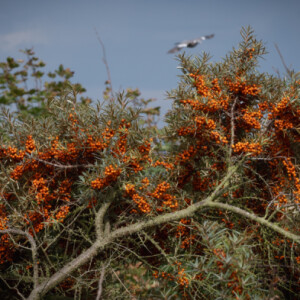Turquoise Sea and Sea Buckthorn
B showed me her walking route in Cromer this morning, which afforded us some very attractive views looking back at the pier. It was very warm and the sun was out for the first part of the walk, which illuminated Cromer beautifully creating this soft light.
Along the clifftops we saw a lot of Sea Buckthorn in flower (see extra). This plant (as well as looking very attractive with its berries), seems to be very useful. They are exceptionally hardy plants, able to withstand winter temperatures as low as −43 °C. As the shrub develops an aggressive and extensive root system, they are planted to inhibit soil erosion and used in land reclamation for their nitrogen fixing properties, wildlife habitat, and soil enrichment. The soil erosion properties are very handy on our crumbling coastline. They are also used in food and cosmetics. When the berries are pressed, the resulting sea buckthorn juice separates into three layers: on top is a thick, orange cream; in the middle, a layer containing sea buckthorn's characteristic high content of saturated and polyunsaturated fats; and the bottom layer is sediment and juice. The upper two layers contain fat sources applicable for cosmetic purposes and can be processed for skin creams and liniments, whereas the bottom layer can be used for edible products such as syrup. I've noticed that a lot of restaurants now seem to be using these berries in their cuisine.


Comments
Sign in or get an account to comment.


